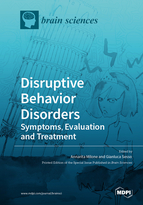Disruptive Behavior Disorders: Symptoms, Evaluation and Treatment
A special issue of Brain Sciences (ISSN 2076-3425). This special issue belongs to the section "Social Cognitive and Affective Neuroscience".
Deadline for manuscript submissions: closed (15 June 2021) | Viewed by 44239
Special Issue Editors
Interests: disruptive behavior disorders; adolescence; empathy; callous–unemotional traits; emotional dysregulation; aggression; prevention; cognitive interventions; psycho-pharmacological treatment
Special Issues, Collections and Topics in MDPI journals
Special Issue Information
Dear Colleagues,
Clinical management of disruptive behavior disorders (DBD) in childhood and adolescence has seen great advances in recent years. Research has focused on identifying early DBD signs and defining specifiers, which may help clinicians to disentangle and subtype the heterogeneous manifestations of BDB. This has allowed significant progress to be made in defining specific developmental trajectories, targeted prevention programs, and timely treatment strategies.
The principal aims of this Special Issue are to address three core features of DBD management:
- Clinical presentations: identifying neural correlates of aggression and irritability, gender-related specificities, predictors of psychosocial and psychopathological outcomes, markers of response to stressful events;
- Multidimensional assessment: executive functioning, empathic competences, callous–unemotional traits, emotional dysregulation, and predictors of antisocial outcome;
- Treatment options: special focus on cognitive interventions (child/adolescent-centered, parenting or family-oriented programs, school interventions and tele-rehabilitation) and pharmacological treatments targeted on specific DBD features (aggression, emotional dysregulation).Special attention will be reserved for original research, especially for observational studies and randomized clinical trials, but systematic reviews and meta-analyses will also be welcomed.
Dr. Annarita Milone
Dr. Gianluca Sesso
Guest Editors
Manuscript Submission Information
Manuscripts should be submitted online at www.mdpi.com by registering and logging in to this website. Once you are registered, click here to go to the submission form. Manuscripts can be submitted until the deadline. All submissions that pass pre-check are peer-reviewed. Accepted papers will be published continuously in the journal (as soon as accepted) and will be listed together on the special issue website. Research articles, review articles as well as short communications are invited. For planned papers, a title and short abstract (about 100 words) can be sent to the Editorial Office for announcement on this website.
Submitted manuscripts should not have been published previously, nor be under consideration for publication elsewhere (except conference proceedings papers). All manuscripts are thoroughly refereed through a single-blind peer-review process. A guide for authors and other relevant information for submission of manuscripts is available on the Instructions for Authors page. Brain Sciences is an international peer-reviewed open access monthly journal published by MDPI.
Please visit the Instructions for Authors page before submitting a manuscript. The Article Processing Charge (APC) for publication in this open access journal is 2200 CHF (Swiss Francs). Submitted papers should be well formatted and use good English. Authors may use MDPI's English editing service prior to publication or during author revisions.
Keywords
- Disruptive behavior disorders
- Childhood
- Adolescence
- Empathy
- Callous–unemotional traits
- Emotional dysregulation
- Aggression
- Executive functions
- Prevention
- Cognitive interventions
- Psycho-pharmacological treatment







